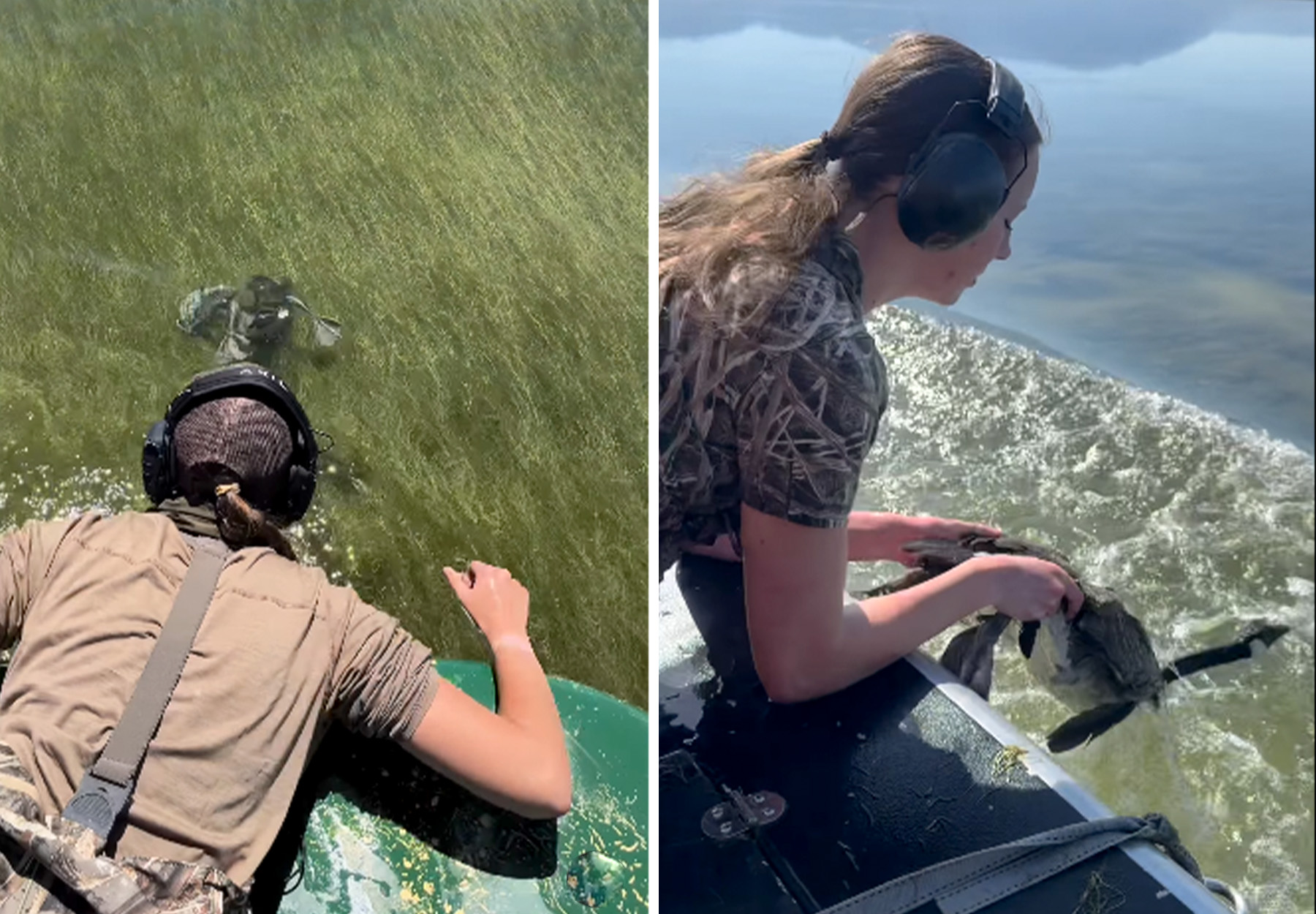If casual visitors to the Bear River Migratory Bird Refuge were paying attention this month, they might have spotted a wader-clad duo hanging off the bow of an airboat and pulling Canada geese out of the Great Salt Lake. The airboat would rip across the water, only slowing so one woman could snatch a goose as it swam through the shallows. And it was all in the name of science.
The two goose catchers in question are volunteer wildlife biologists with the Utah Department of Wildlife Resources, and their unorthodox technique appeared in an Instagram video shared June 14. The two were helping with the agency’s goose-banding program, which for decades has provided ample data for the state’s wildlife managers.
DWR’s waterfowl banding program has been in operation since 1965, program lead Rich Hansen tells Outdoor Life. He says that while there are several different ways to catch and band geese, the DWR often focuses its efforts on the shallow flats of the refuge because the geese can’t dive down to unreachable depths there. Instead, the birds submerge themselves and swim along the shallow lake bottom, where volunteers can easily snatch them. The geese are carefully caged, brought to shore, banded, and released within a few hours.
“The marshes of the Great Salt Lake are so shallow, anywhere from a foot deep to two-and-a-half feet deep,” Hansen says. “If they’re on deeper water, they’re really tough to catch. We actually have to set a trap up on shore, put wing walls out, and funnel them into the trap … but we have all these wetlands associated with the Great Salt Lake, so we have a lot of waterfowl biologists, and a lot of airboats and equipment.”
Hansen and other members of the waterfowl team do observational flights over the refuge about a week before a banding day to get an idea of where the geese are congregating. Flocks tend to gather on any one of the refuge’s many impoundments, Hansen says, on the northeast corner of the Great Salt Lake. Once the biologists have an idea of where to go, they launch their airboats and surround the flock, singling out individuals to fit with durable stainless-steel leg bands.
Read Next: Watch: Hundreds of Mallards Swim Out of Flooded Timber, Swarming Hunters
“Once an airboat pulls up on them, they tend to duck out of the way, so we put volunteers at the front of the boat to pluck them out of the water,” Hansen says of the techniqu.
Hansen estimates that roughly 10 percent of the geese they capture in a typical year are already banded. They’ll run those unique band numbers through the USGS Bird Banding laboratory database and update what biological information they can. This is the same resource waterfowl hunters should use to report the banded birds they harvest so they can add to a growing body of research around the birds, Hansen points out.
Many of these banded geese are captured multiple times, and Hansen says a handful of birds between 17 and 21 years old end up in the DWR’s banding stations every year. They recently captured a Canada goose that was first banded in 2005.
Part of the reason some of these geese live so long is because they’re a resident population,” Hansen says. “There are some geese that migrate through the area, Hansen says, since the Great Salt Lake and the larger Bear River watershed provide crucial stopover habitat for birds in the Pacific Flyway. But the resident birds that stick around tend to wise up pretty quickly.
“They live a lot longer than most people would think,” Hansen says. “Those birds typically go to the city as soon as the shooting starts … These birds are pretty smart, and to survive that long they know when to get to the city and they know how long to stay in the city.”
Read Next: What Happens to Duck Hunting When the Great Salt Lake Dries Up?
Hansen says 2024 marks the 59th year of the DWR’s banding program. And over all that time, they’ve handled hundreds of thousands of birds.
“I think we have one of the longest-running banding projects in the nation, and I know we’ve banded more geese than any other state west of the Rockies,” Hansen says. “From 1965 through 2003, the state had banded about 65,000 geese. I took over in 2004 and we’ve banded another 60,000 since then. So we’ve banded about 125,000 geese. It’s a pretty big effort … and it’s helped us a lot.”
Read the full article here
